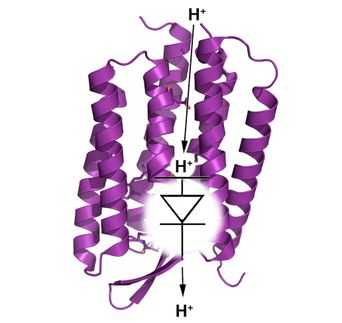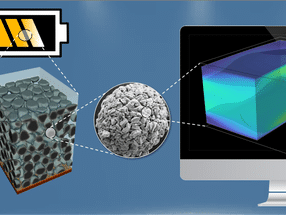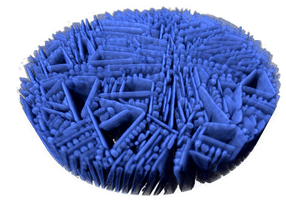Cornell's Stroock lab creates first synthetic tree
World's first synthetic tree is no giant redwood, but may lead to technologies for heat transfer, soil remediation
In Abraham Stroock's lab at Cornell, the world's first synthetic tree sits in a palm-sized piece of clear, flexible hydrogel - the type found in soft contact lenses. Stroock and graduate student Tobias Wheeler have created a "tree" that simulates the process of transpiration, the cohesive capillary action that allows trees to wick moisture upward to their highest branches.
The researchers' work, reported in Nature, bolsters the long-standing theory that transpiration in trees and plants is a purely physical process, requiring no biological energy. It also may lead to new passive heat transfer technologies for cars or buildings, better methods for remediating soil and more effective ways to draw water out of partially dry ground.
Of course, the synthetic tree doesn't look much like a tree at all. It consists of two circles side by side in the gel, patterned with evenly spaced microfluidic channels to mimic a tree's vascular system. In nature, trees use water in tubular tissues, called xylem, like ropes that pull more water out of the ground, delivering it to leaves. They manipulate the water in the xylem under negative pressure - what's called a metastable liquid state - right on the verge of becoming a vapor. Xylem-like capillaries are relatively easy to create by microfabrication, but the researchers' choice of a material to act as membranes in the leaf and root to separate the liquid from the atmosphere and the soil was much trickier.
Stroock, assistant professor of chemical and biomolecular engineering, and Wheeler, a graduate student in his lab, used pHEMA hydrogel, or polyhydroxyethyl methacrylate, to form the plant membranes. The hydrogel is a solid embedded with water and has nanometer-scale pores. The material acts as a wick by holding liquid in the pores, through which capillary action creates tension in the water.
By building mimics of xylem capillaries within the gels, the scientists were able to create negative-pressures of the magnitude observed in trees, and to pump water against large resistances and out of subsaturated, or partially dry, sources.
Besides supporting the theory of transpiration as a physical, not biological, process, the synthetic tree also introduces a new way to study water under tension - a subject interesting to physicists and chemists. Many questions about the metastable state of water could be answered using this new "tree."
Most read news
Other news from the department science

Get the chemical industry in your inbox
From now on, don't miss a thing: Our newsletter for the chemical industry, analytics, lab technology and process engineering brings you up to date every Tuesday and Thursday. The latest industry news, product highlights and innovations - compact and easy to understand in your inbox. Researched by us so you don't have to.



























































